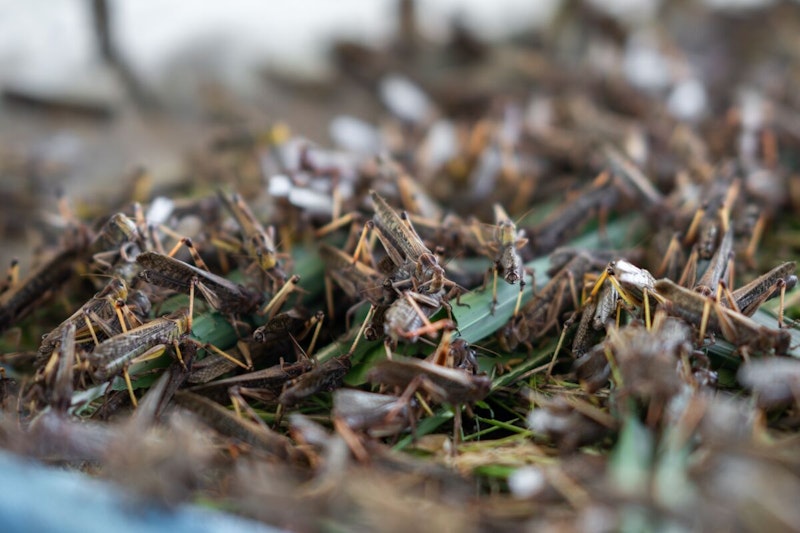Study Notes
GCSE Geography | Causes of Food Insecurity (Resource Management - Food 2)
- Level:
- GCSE
- Board:
- AQA, Edexcel, OCR, Eduqas
Last updated 25 May 2024
Many people in LICs suffer from food insecurity, where they do not have access to sufficient, safe, nutritious food to maintain a healthy and active life. These populations tend to be rural, meaning that they do not have access to shops to buy food, so therefore have to grow what they eat, or depend on small village markets, buying produce that has been grown locally. Food supply in these areas is often affected by drought and desertification, pests and diseases, conflict and a lack of technology.
Climate
Drought
This is a really common cause of food insecurity as crops struggle to grow where it is too dry, and hot temperatures mean that evaporation rates are high, causing the land to dry out even more quickly. Drought means a long period of below average rainfall - it leads to crops withering and dying, but can also affect livestock too, destroying their food supply and making them weak from a lack of drinking water, leading to livestock deaths. Loss of crops and livestock can lead to undernourishment and eventually starvation for people living in areas affected. Some regions in Africa have suffered from drought for many years, for example, the Sahel, just south of the Sahara Desert. Long periods of drought can lead to the process of desertification, whereby previously fertile land turns into arid desert - click here for more information.
Flooding
In complete contrast, flood events can also lead to food insecurity as crops are washed away and livestock drown - this often happens during tropical storms, such as Typhoon Haiyan which hit the Philippines in 2013, and had a catastrophic impact on food supplies in the region.
Climate change
Climate change is leading to more extremes of weather, for example, more frequent and more intense tropical storms in the regions that already experience them, and more heatwaves and drought events, meaning that it will be even more challenging to grow crops, rear livestock and maintain food supply in the future.

Pests and diseases
The climate in LICs makes people vulnerable to a variety of pests that can harm crops, such as locusts who often destroy whole harvests. Poverty also means that farmers are unable to use pesticides to protect their crops from this threat. In addition, facilities used to store grain in LICs can be poor, meaning that what has been grown is often eaten by rodents.
Cattle in LICs often suffer from diseases such as bovine pleuropneumonia, which attacks the lungs causing fever and respiratory problems. They will struggle to recover from this due to a lack of veterinary care, but also having weakened immune systems due to being undernourished.
Finally, human diseases such as malaria and AIDS are common in the world's poorest nations, making those suffering much weaker and therefore unable to farm so efficiently. And in areas where there is a high mortality rate from these, then the available workforce for farming will be reduced.

Technology
Farmers living in LICs do not have the money to invest in the technology that would make their job easier and more productive, e.g. they can't afford drought resistant seeds, better tools (which is particularly important when most farming is done by hand), or chemical fertilisers and pesticides, that have all been developed to improve crop yields, and therefore food supplies and profitability.
On a larger-scale there is also a lack of investment into systems that would make agriculture more efficient, such as transportation, huge warehouses that could safely store produce, large-scale irrigation systems, and machinery that would enable farmers to plant and harvest much bigger areas of land, which would increase their crop yields. This of course is directly linked to poverty.

Conflict
There are many ways in which conflict can lead to food insecurity. When a country is at war the main priority becomes fighting, which can mean that those who would normally work the land are recruited as soldiers instead, disrupting food and farming. Wars also lead to huge numbers of people fleeing from their homes to safety, leaving behind their land, and heading to vast refugee camps with nothing to eat, which can currently be seen in Yemen which is experiencing civil war with hundreds of thousands of people living with hunger. Food supplies can also been targeted by soldiers - either seized or destroyed with the idea of making the population as weak as possible, along with the deliberate contaminating of wells and water supplies. Farmland is often destroyed to make it much harder for local people to use it productively in the future.
In times of conflict, charities and aid workers will try to help those most in need by providing emergency supplies of food. However, there are times when aid workers are stopped from reaching those who desperately need help, or travelling into zones of conflict becomes too dangerous for them. Long-term aid is also available to help improve food supplies for the future, but government corruption often means this money doesn't get to the people who actually need it.
Over the last few decades many LICs have experienced civil war, which has led to widespread famine and starvation.

You might also like
What is a Resource?
Study Notes
Energy - the Coal Trade
Study Notes
Energy - the Oil Trade
Study Notes

When the new Resource Frontier is on the sea bed 2km below the surface
13th September 2017
McDonalds to start using paper straws
18th June 2018
Resource Management: Energy - GCSE MCQ Quiz
Quizzes & Activities
‘Clear the Deck’ Interactive Revision Quiz for Paper 2: Resource Management - UK
Quizzes & Activities
